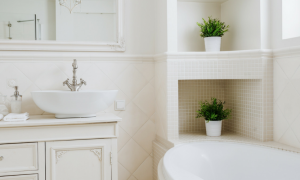How to Prevent Mold in Your Home
One of the most common places where mold forms is in the bathroom. Prevent mold’s growth in and around your home by paying attention to practices that allow mold to thrive.
People generate moisture through everyday living, especially in the summer when people fight humidity with air conditioning. The resulting moisture in turn generates mold. One of the most common places where mold forms is in the bathroom. Bathroom mold left untreated can be dangerous. The warm moisture from showers and baths is a breeding ground for mold and can spread.
Mold is dangerous to persons with breathing conditions and will also cause damage to lung function in persons who have not been previously affected. Mold is characterized by an earthy smell and has velvet-like texture, variant in color, including white, green, brown, black and even yellow. Mold growth is powered by humidity in the air, standing water from outside a home, a sprinkler system, the air condition drip pan and more. Poor ventilation of a kitchen or bathroom will also contribute to the growth of mold.
It is recommended that homeowners do not personally test their homes for mold, saying it is expensive and should only be completed by professionals. Homeowners should inspect for mold but not test. Inspecting for mold includes searching for evidence of mold, looking for signs of moisture, water damage, and fungus (the very definition of mold).
Prevent mold’s growth in and around your home by paying attention to practices that allow mold to thrive. For instance: ventilate the bathroom when showering and pull the shower curtain closed to dry. If the bathroom does not have a good ventilation system, be sure to wipe down the walls of the shower and bath following use. Remember bathroom mold loves moisture, so eliminate it at every cause.
When carpets or rugs get wet, they become a catalyst for mold. It is essential to get them dry quickly. Hang them on an outdoor line, throw in the dryer or air out carpets as quickly as possible, by opening windows and blowing fans. Also, don’t let spills linger. Wipe them up as quickly as possible and do not leave standing water in containers in and around your home.
Finally, if mold is present in your home clean it with care, but only if you are non-allergic and do not have a health condition that will be exacerbated by the presence of mold.
Do not lay carpet in areas where moisture is a constant. Keep rugs and carpets out of bathrooms. If your home has a basement, avoid carpeting the bottom floor.
Run the air conditioning or a humidifier to keep humidity at a reasonable level. Humidity below sixty percent will keep mold at bay. When cleaning, soapy water is a deterrent along with a mold or mildew cleaner, and afterward dry up the area well. If the mold returns, you may have a bigger problem than surface mold. The Environmental Protection Agency may be able to help you.




